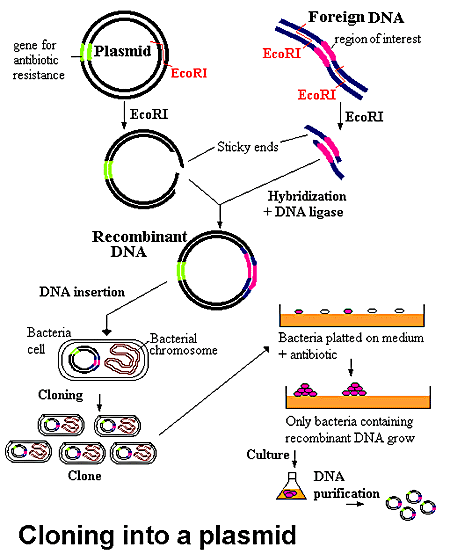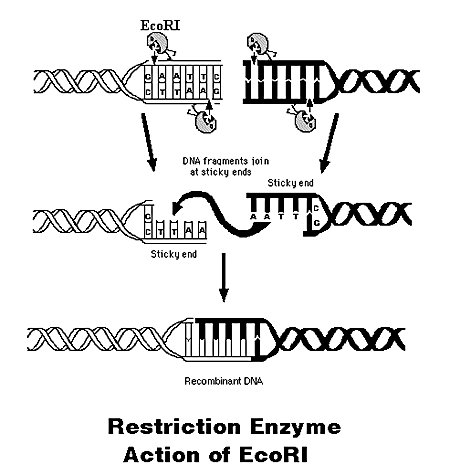All living organisms
are made up of countless, minute cells. These cells contain a nucleus that is
made up of Deoxyribose Nucleic Acid (DNA) located on chromosomes. All of the
information that forms an organism and keeps it functioning is found in this
DNA. The DNA can be further broken down into genes, which are sections of DNA
that determine particular characteristics. The instructions from these genes
ensure that specific proteins are formed, thus allowing the structure of the organism
to be created.
 |
| http://www.biotechnologyonline.gov.au/popups/img_cell.html |
In order for the
gene that carries a certain characteristic to be found within the DNA, a
single-stranded piece of DNA, known as a gene probe is used to search for the
unique base sequence of the gene. Through designing a particular base sequence
for the probe, which corresponds to that of the gene, the section of DNA can be
located. The base sequence can consist of any arrangement of adenine (A),
cytosine (C), guanine (G) and thymine (T), with A complimenting T and C complimenting
G. For example if the gene consisted of the base sequence, AGGCTC, then a gene
probe would need to be designed with the base sequence, TCCGAG, so that
complimentary pairs would match up.
 |
| http://www.biotechnologyonline.gov.au/popups/img_helix.html |
Before testing the
DNA, the double-stranded DNA molecules must be unzipped through a certain
treatment. Once the DNA is unzipped into single strands, the gene probe can
attach itself to the specific section of DNA. This probe is also easily
detected, as it is fluorescent.
 |
| http://tle.westone.wa.gov.au/content/file/969144ed-0d3b-fa04-2e88-8b23de2a630c/1/human_bio_science_3b.zip/content/005_dna/images/pic043.gif |
You may be wondering
how DNA testing relates to genetic modification. Well, once the gene is
located, its chromosome and position on the chromosome can be determined;
therefore the gene can be cut from the DNA of the organism and pasted into a
different organism or into a new position on the same organism. This process is
referred to as ‘gene splicing’. To cut sections of DNA, a group of chemicals,
known as restriction enzymes are used. These restriction enzymes were
originally located within bacteria, with their role being to act as defence
against foreign DNA. They are a defence mechanism that inactivates the foreign
DNA by cutting it up, thus they are very efficient in slicing sections of DNA
when used in genetic modification.
Specific restriction
enzymes cut different sections of DNA. For example, the enzyme EcoRI (taken
from the human bacteria, E.coli) recognises the sequence GAATTC and cuts the
DNA between the guanine (G) and adenine (A). Furthermore, restriction
enzymes can be used on any organism, as all organisms are chemically identical
(i.e. their DNA contains the same bases, just different arrangements).
 |
| http://explorebio.wikispaces.com/file/view/sticky_ends.jpg/204841238/sticky_ends.jpg |
Once the section of
DNA has been cut, it is pasted into a new chromosome or plasmid (small circular
DNA molecule found in bacteria) so that it can be transferred to another
organism. The same restriction enzymes are used to cut the plasmid or
chromosome using the sticky ends method, so that it has the same base sequence
as the end of the section of DNA. The overhanging stands of DNA are then bound
using the enzyme, ligase, thus pasting it together.
This newly pasted
section of DNA is then cloned so that it can be inserted into a variety of
different organisms or used multiple times in order to ensure a higher success
rate of transforming the cell. The plasmid or chromosome containing the new DNA
(referred to as recombinant) is cloned through a process of asexual
reproduction and division. In the case of bacteria, the plasmid is introduced
into a separate bacterium, where it is spread onto nutrient rich agar plates.
Each bacterium then grows into millions of cells that are identical to the
recombinant plasmid. This results in many more genes being available for
insertion into organisms.
 |
|
http://www.bio.davidson.edu/courses/Molbio/MolStudents/spring99/alex/PLASMID.gif
|
When the gene is to be
inserted into a new cell, another process called transformation is to be undertaken.
This is due to the fact that the DNA must be taken out of the nucleus of its
current cell and inserted into the nucleus of the new cell. The DNA must pass
through the cell membrane and in some cases, the cell wall, then finally the nuclear
membrane. The process is different depending on whether the organism is an
animal or a plant and this will be explained further in the next two blog
posts.
Eat Safe!
Dr Georga Leisemann (Feeding Your Family)

No comments:
Post a Comment